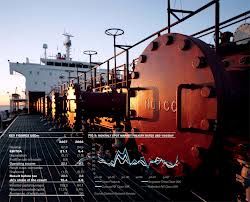
In what appears to be yet another testament of the volatile nature of the spot tanker freight rate markets, with major turnarounds occuring in a few weeks. The products tanker market is no exception to the rule, in fact it highlights the above trend quite vividly. According to a recent report from London-based shipbroker Gibson, "during the first quarter of this year, MRs in the West notably outperformed all product tanker categories in the East. During this period, MR tce earnings trading UK Continent – US Atlantic Coast (TC2) averaged close to $$14,000/day at market speed (13 knots l aden/12 knots ballast); comfortably above the level needed to cover fixed operating expenses. Firmer returns have been supported by both temporary and fundamental factors, such as some weather related delays and disruptions, occasional wide arbitrage to ship gasoline to the US and more importantly the rapid growth in US distillate and gasoline exports. This product export opportunities boosted MR earnings above the round voyage calculations on the TC2 trade. In stark contrast, returns for all product tanker categories in the East averaged at their lowest level in over a decade during the fi rst quarter of 2012, below fixed operating costs. This extreme weakness in the product tanker market in the East was underpinned by the toxic mix of the weakness in chartering demand and ample supply of spot ships" said Gibson.
It added that "clean tanker rates and earnings in different regional markets moved closer together in the second quarter of this year, ass trading conditions in the East started to improve, while the market for MMRs in the West started to soften. These trends accelerated inn July, with LR1 and LR2 tce earnings for Middle East –Japan peaking last month at their highest level in nearly two years, while MR earnings for UK Continent – USAC collapsed too their lowest level since November 20009
However, the picture is changing again. Currently clean tanker rates in the Eastern markets are in decline, following the slowdown in chartering demand, in part due to Ramadan. In contrast, MR charter costs in the Atlantic Basin are on the upward path amid some tightening in tonnage availability (although they still remain below fixed operating costs). The latest developments are simply yet another example of the volatile nature of spot freight rates and if current trend continue, we may see another “change of fortunes” in the West versus East. However, freight rates in the West could find support if we are to see a very active hurricane season, while the third quarter of each year is usually the strongest for the products market in the Middle East and the Asia Pacific" concluded Gibson.
Meanwhile, in the tanker markets this week and more specifically in the Middle East, it was "another uninspiring week on the VLCC market and as Charterers reach out into the next fixing window owners seem resigned to the fact that there are no impending signs of any recovery. The week ends at similar levels to last week of WS 36.5 East and 24 West but with oil and bunker prices continuing to rise the earnings for Owners are worsening. The area has seen a much improved week for Suezmaxes and Aframaxes. Suezmaxes were tested to see if they could maintain the improvement from last week, and Indian Charterers helped to keep the market active and rates steadied around WS 82.5 for a modern vessel. VLCCs fixing part cargoes and older units helped to take away the initiative from the Owners. AG/West runs reduced in volume and accordingly rates reduced down to 140 x WS 50 level, where we expect the market to settle. The revival of Marsa Bashayer stems has brought a new dimension to the Aframax market and as tonnage has thinned we have seen rates increase from WS95 to WS105 reported today" Gibson said.
In the Mediterranean, "with more and more crude heading to Europe on Suezmaxes, and less cargoes going to Asia recently, this market is so over-tonnaged that Charterers have had no problem in keeping the rates at their minimum return rates of 140x55 from Black Sea. Due to the current state of the Aframax market, we may see a few more shipping people practicing yoga and meditation just to kill time. Rates stay pressured between WS 77.5-WS 80 for 80,000 cross MED. Even though there was a premium of WS 87.5 paid for Black Sea-MED voyage for a replacement business, the overall level stays flat. Owners are now digging their heels in and not accepting anything below WS 80" the shipbroker said.
Finally, in the North Sea, "a couple of VLCCs were concluded for Continent/East reportedly for crude and fuel oil, a shade above 3.0mill levels. Suezmaxes saw very little enquiry with 135xw50 paid for Mongstad to Philadelphia. For Aframaxes it’s like an old tape stuck in an old, broken recorder. Rates stay flat within 80,000 by WS 82.5/80 cross UKC and 100,000 by WS 60-62.5 from the Baltic. After an active start to the week, enquiry levels were dropping quickly, passing beyond the “Boredom” milestone by Thursday. The fixing window is now in the second half of September’s first decade, making the list of available vessels looking long, hungry and hoping for some action to come its way after the three-day break" Gibson concluded.
Nikos Roussanoglou, Hellenic Shipping News Worldwide
We use cookies to improve your experience. By continuing to use our site, you accept our Cookies, Privacy Policy,Terms and Conditions. Close X